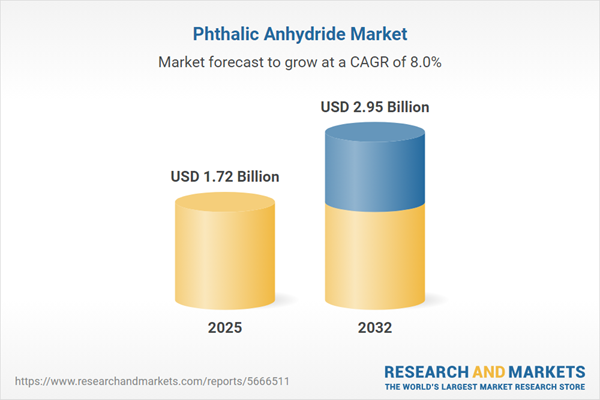Speak directly to the analyst to clarify any post sales queries you may have.
Senior executives overseeing the global phthalic anhydride market face a dynamic environment, balancing operational efficiency, regulatory mandates, and resilient supply chains. Achieving sustained competitiveness in the specialty chemical sector requires digital alignment and robust risk management, underpinned by proactive adaptation to compliance trends.
Market Snapshot: Strategic Growth and Complexity in the Phthalic Anhydride Market
The global phthalic anhydride market continues a steady growth trajectory, propelled by enduring demand from plastics, coatings, construction materials, and detergent industries. As organizations navigate rising complexity, executive priorities emphasize automation and digitalization to enhance scalability and reliability in chemical supply. Regulatory developments and sustainability initiatives now shape procurement decisions, with phthalic anhydride serving as a foundation for risk-managed, cross-industry operations. This intricate environment requires precise oversight of both supply chain robustness and operational continuity, positioning chemical leaders at the center of market transformation.
Scope & Segmentation of the Phthalic Anhydride Market
This report presents actionable segmentation intelligence for senior leadership, forming a foundation for strategic sourcing, risk mitigation, and growth planning within specialty chemicals. The analysis includes:
- Product Grades: Cosmetic, electronic, food, and technical grades optimized for specific industrial and consumer uses. These grades address quality and compliance requirements unique to different sectors.
- Purity Tiers: Standard and ultra-high purity phthalic anhydride designed for applications in sectors such as pharmaceuticals and electronics. Purity options help organizations achieve regulatory conformance for sensitive manufacturing environments.
- Production Processes: Air oxidation, fluidized bed, and gas phase manufacturing methods—each facilitating efficiency improvements matching sector needs.
- Applications: Alkyd resins, polyester resins, plasticizers, detergents, and composite materials, which act to expand client portfolios and drive innovation in downstream industries.
- End Use Industries: Automotive, construction, electrical, furniture, textiles, and electronics manufacturing, with each sector influencing how organizations structure procurement approaches and compliance strategies.
- Sales Channels: Direct supply, distributor networks, and online procurement platforms to broaden material access and maintain reliable fulfillment across global and regional markets.
- Regional Coverage: Comprehensive market coverage in North America, Latin America, Europe, Middle East, Africa, and Asia-Pacific. Key markets like the United States, China, Germany, India, and Brazil are analyzed for regulatory, supply, and demand shifts.
- Key Companies Covered: Strategic benchmarking includes leading chemical producers: Eastman Chemical Company, BASF SE, LG Chem Ltd., and Sinopec Yanshan Petrochemical Company.
Key Takeaways for Senior Decision-Makers
- Implementing advanced catalyst technologies and production automation supports compliance in environmentally stringent sectors and increases operational efficiency.
- Expanding the supplier network across multiple regions improves sourcing flexibility and reduces exposure to supply chain disruptions by enabling swift response to localized risks.
- Integrating sustainability priorities into procurement and production strategies builds regulatory resilience and strengthens relationships with stakeholders throughout the value chain.
- Diversifying product grades and purity tiers allows market entry into regulated and high-growth segments, including food-contact, healthcare, and electronics manufacturing applications.
- Digital procurement combined with real-time market monitoring empowers rapid adjustment of sourcing strategies as regulatory or operational factors change.
Tariff Impact: Navigating U.S. Trade Policy in the Phthalic Anhydride Market
Ongoing U.S. tariffs affecting imported phthalic anhydride require senior leaders to reevaluate sourcing portfolios and adapt logistics strategies. Updates to customs operations and supplier evaluation now play a crucial role in maintaining a competitive stance. Leveraging access to specialized advisory resources and establishing flexible procurement frameworks are central to reducing disruption and safeguarding supply chain integrity as global trade dynamics shift.
Methodology & Data Sources
The report’s analysis draws on direct interviews with senior decision-makers, comprehensive market surveys, and systematic reviews of technical publications and regulatory guidelines. Peer review processes validate findings, ensuring actionable, reliable insight for each segment of the phthalic anhydride value chain.
Why This Report Matters
- Provides strategic foresight that helps organizations adapt procurement and compliance policies to evolving regulatory and sustainability trends in the phthalic anhydride sector.
- Delivers benchmarking across the supplier landscape, enabling decision-makers to shape sourcing, mitigate risk, and build sustainable business partnerships.
- Empowers rapid response to market and regulatory changes, streamlining supply chain decisions for stronger operational resilience and business continuity.
Conclusion
This report equips senior leaders with targeted market intelligence to navigate evolving regulatory frameworks and capture emerging opportunities within the phthalic anhydride market. Its strategic insights support agile, evidence-based decisions for ongoing operational success.
Additional Product Information:
- Purchase of this report includes 1 year online access with quarterly updates.
- This report can be updated on request. Please contact our Customer Experience team using the Ask a Question widget on our website.
Table of Contents
3. Executive Summary
4. Market Overview
7. Cumulative Impact of Artificial Intelligence 2025
Companies Mentioned
The companies profiled in this Phthalic Anhydride market report include:- Eastman Chemical Company
- BASF SE
- LG Chem Ltd.
- Sinopec Yanshan Petrochemical Company
- I G Petrochemicals Ltd. (IGPL)
- nan ya plastics corporation
- NIPPON SHOKUBAI TRADING CO.,LTD.
- Xinnuo Lixing (Huanghua) Group Co., Ltd.
Table Information
| Report Attribute | Details |
|---|---|
| No. of Pages | 180 |
| Published | November 2025 |
| Forecast Period | 2025 - 2032 |
| Estimated Market Value ( USD | $ 1.72 Billion |
| Forecasted Market Value ( USD | $ 2.95 Billion |
| Compound Annual Growth Rate | 8.0% |
| Regions Covered | Global |
| No. of Companies Mentioned | 9 |









